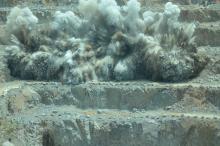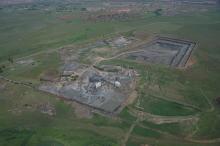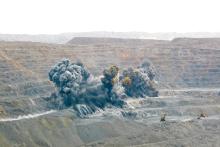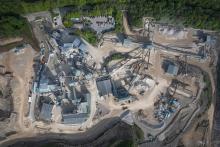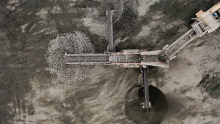
The importance of energy containment in achieving positive blast outcomes cannot be stated enough. ERG Industrial, a specialist in blast optimisation for quarries and mines, has observed a growing understanding of the value of energy confinement in blasting, with many in the industry realising that stemming should not be an afterthought. Munesu Shoko reports
In blasting, says Eugene Preis, managing director of ERG Industrial, energy follows the path of least resistance, which in most cases is right up and out of the blasthole. Good stemming, therefore, creates more resistance at the top of the blast hole and directs the energy to where it is needed—the rock mass.

Insufficient, inconsistent, or inefficient stemming allows the blast energy to vent prematurely at the collar, reducing the energy applied to breaking and moving the rock mass. Stemming ejection is a common cause of lost energy in the blast, especially when drill cuttings are used. Lost energy in blasts manifests itself as air overpressure, ground vibration, and sub-par fragmentation.
“We do see a trend where mines and quarries are focusing more on energy confinement in blasts. Many more operations are now paying attention to the quality of their stemming and realise that it is not just a matter of throwing any material in the hole to resist the force,” says Preis.
Good stemming creates better resistance in the blast hole, leading to a range of benefits. The knock-on effect of better energy containment is significant. On the health and safety side, there is a marked reduction in flyrock, noise and airblast. From a productivity point of view, there is an improvement in fragmentation.
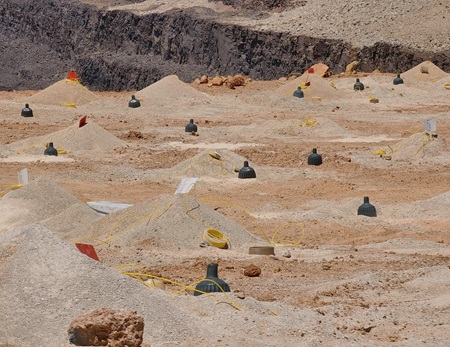
Different types of stemming materials are used in blasting, including crushed aggregate, drill chippings, and clay. Because quarries produce aggregate, quarries have traditionally used crushed aggregate as stemming material. However, for most mines, it is not economically feasible and/or accessible to use crushed aggregate, so operations tend to use drill chippings or cuttings.
According to Preis, operations that use the right-sized aggregate for stemming are leaders of the pack. “Crushed aggregate has great interlocking properties because of the sizing of the stone. If you apply pressure to a column of aggregate, you get good interlocking, and that, in turn, creates a counter force against the pressure being exerted by the force of the blast,” he says.
However, he adds, the downside of using aggregate alone is that because of the particle size, there is room for contamination of the upper part of the explosives. The weight and size of the aggregate can sink into a portion of the explosives, which reduces the effectiveness of the ‘bang’. In most cases, this results in additional oversize in the upper layer of the block or the capping layer.
“Additionally, because there are so many spaces and voids between the rock particles, there is no effective containment of explosive gases and shockwave. However, despite this and the issue of contamination, aggregate still does the job better than most other stemming materials,” says Preis.

Typically, the loss of explosive energy through stemming ejection reduces the blast's performance. The core principle behind stemming plugs such as the Varistem, which is supplied globally by ERG Industrial, is to improve the effectiveness of stemming material in the blasthole. As a result, this improvement helps to better contain the explosive energy within the rock mass and thus yield a more controlled and efficient blast.
“A stemming plug is not a standalone solution; it works in conjunction with stemming material, whether aggregate or drill chippings, to help contain energy more effectively,” says Preis. “As soon as the initial blast force is exerted onto the stemming plug, it engages with stemming material and compacts it, forcing itself into any voids between the stemming material and the sides of the hole. As a result, there is better retention of the shockwave gases within the rock mass because the combination of the stemming plug and stemming material have formed a temporary pressure seal,” explains Preis.
Commenting on some of the key benefits of stemming plugs, Preis says there are several follow-up effects to better energy containment. For quarries, one of the biggest challenges is their proximity to communities and existing infrastructure. In line with the requirements of South Africa’s Regulation 4.16(2) of the Mining Health and Safety Act’s Explosives Regulations of 2018, quarries need to acquire a licence to blast within 500m of structures.

“Because quarries are by their nature close to communities and existing infrastructure, they need to find ways to control flyrock and keep their noise and airblast down. Using stemming plugs reduces the likelihood of stemming ejection and flyrock. As a result, most of our clients in the quarrying space use our Varistem stemming plugs for that reason,” says Preis.
On the productivity side of things, due to their better energy containment properties, stemming plugs help improve fragmentation and reduce oversized material in blasts. The benefits of good fragmentation are well documented, says Preis.
“Firstly, good fragmentation eliminates the need for costly secondary blasting or mechanical breaking of oversize material. Secondly, there is a positive impact on downstream processes such as load and haul. Crusher throughput also increases due to improved overall particle size distribution,” he says.
A key trend in the quarrying sector, says Preis, is that there is almost always a trade-off between productivity and health and safety, and in most cases the latter wins. Quarries are overly cautious when it comes to stemming heights in their blast designs. They therefore design their blasts to produce no flyrock, but in the end they get oversize in the top stemming layer.
“By incorporating a stemming plug such as Varistem in their blast designs, quarries can reduce their stemming heights, for example, by leaving an air deck. By using this solution, they can keep flyrock down, while at the same time deal with the oversize problem. The system, therefore, offers great value on both fronts – productivity and health and safety,” he says.
With mines and quarries fast realising the massive benefits offered by stemming plugs, Preis says that the rate of adoption has increased significantly in the past few years. Central to the growing uptake is ERG Industrial’s ability to prove the capabilities of the technology through scientific evidence.
“Initially, 99% of our engagements with potential clients were not successful. We quickly realised that there was a misconception about stemming devices, stemming in general and its value in the blasting process,” he says. “We started doing infield tests to demonstrate the capabilities of the product and to build collateral. The science behind the product made sense, but the tests were meant to prove to the customer what could be achieved in their unique operating environments.”
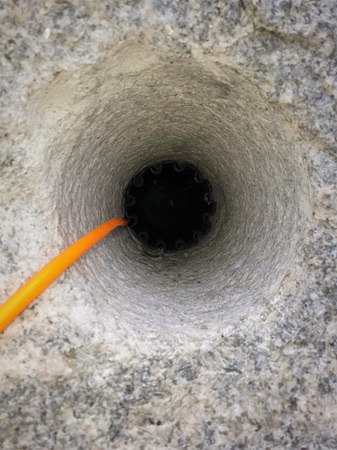
Based on the current shift in attitude towards stemming plugs, Preis foresees a rapid increase in adoption in future. “We have had more mining and quarrying companies coming on board in the past year than we had in the previous four years,” he says.
Preis says there is a better understanding that drill and blast, as the very first process in the quarrying and mining value chain, has a significant bearing on the performance of all other downstream processes. By making a small change in outcomes at the beginning of the value chain, operations can see exponential gains downstream.
“From a macro perspective, if all mining and quarrying operations were able to improve their blast outcomes by 5%, for instance, there would be an incredible knock-on effect on their bottom line, and effectively on the industry’s contribution to the economy at large,” concludes Preis.


